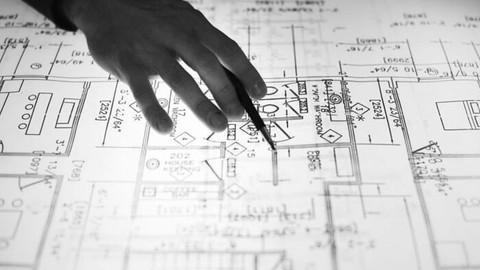Last Updated on September 26, 2023 by GeeksGod
Course : Civil Engineering Structural Shop Drawing in AutoCAD
Part 1: Introduction for beginner civil engineers in manual calculation of structural elements
In this section, we will cover the manual calculation of various structural elements commonly used in civil engineering projects. This will help beginner civil engineers gain a deeper understanding of the design process and enable them to perform accurate calculations.
1- Slab thickness: One of the key aspects of designing a structural slab is determining its thickness. We will discuss different types of slabs, including waffle slabs (type 1 and type 2), ribbed slabs, solid slabs, and flat slabs. We will explore the properties, advantages, and disadvantages of each slab type, and demonstrate how to manually calculate their thickness.
2- Beams thickness: We will also delve into the design of interior and exterior beams in various types of slabs. Understanding how to select an optimized design for the slab-beam system is crucial for ensuring structural integrity and efficiency.
Part 2: Learning the basics commands in AutoCAD for structural shop drawing
Before diving into the practice of creating shop drawings, it is essential to have a good grasp of the basic commands in AutoCAD. This section will serve as a quick tutorial on the fundamental commands that are commonly used in structural shop drawings. Mastering these commands will help you navigate the software with ease and efficiency.
Here are some of the essential commands we will cover:
- How to draw lines
- How to draw polylines
- How to copy and move objects
- How to draw X-lines
- How to draw circles
- How to apply hatching in AutoCAD
- How to match properties in AutoCAD
- How to print a sheet in AutoCAD
Part 3: Shop Drawing Practice for Civil Engineering Projects
In this section, we will guide students on how to begin the shop drawing process for a civil engineering project. We will break down each step and provide detailed instructions to ensure a comprehensive understanding.
1- Drawing the structural axes: The first step in creating shop drawings is accurately drawing the structural axes of the project. We will explain the importance of this step and provide guidance on how to execute it effectively.
2- Distributing the columns: Proper distribution of columns is crucial for maintaining structural stability and load-bearing capacity. We will demonstrate the correct approach to distribute columns and share tips for optimizing their placement.
3- Drawing the column’s details and elevation: We will delve into the process of drawing detailed views and elevations of the columns. Emphasis will be placed on capturing essential information and ensuring clarity in the drawings.
4- Reinforcing the columns: Understanding how to add reinforcement to columns is essential for enhancing their strength and durability. We will illustrate the reinforcement process and provide a comprehensive guide, including the creation of a reinforcement table.
5- Drawing the slabs layout and reinforcement: Slabs play a significant role in structural design, and accurately representing their layout and reinforcement is vital. We will demonstrate how to draw the layout of slabs and reinforce them effectively.
6- Drawing the beams layout and reinforcement: Beams contribute to the overall strength and stability of a structure. We will guide you on how to create the layout of beams and reinforce them to meet design requirements.
7- Drawing the details of beams and sections: Paying attention to the details of beams and sections is necessary for precise shop drawings. We will explain how to capture these details accurately and include them in the drawings.
8- Drawing the foundation layout: The foundation is the base of any structure, and its proper representation is crucial. We will teach you how to draw the layout of foundations accurately, considering factors such as load, soil type, and structural design.
9- Drawing the sections of the foundations: Creating detailed sections of the foundations helps in understanding their construction and reinforcing process. We will demonstrate how to draw clear and informative sections.
10- Reinforcing the foundations: To ensure the stability and longevity of a structure, it is essential to reinforce the foundations correctly. We will provide guidance on how to reinforce the foundations effectively.
By following the steps and instructions provided in this comprehensive guide, beginner civil engineers can enhance their understanding of structural shop drawing and improve their skills in manual calculations. Make sure to take advantage of Free Udemy Coupon for “Civil Engineering Structural Shop Drawing” to further expand your knowledge in this area.














